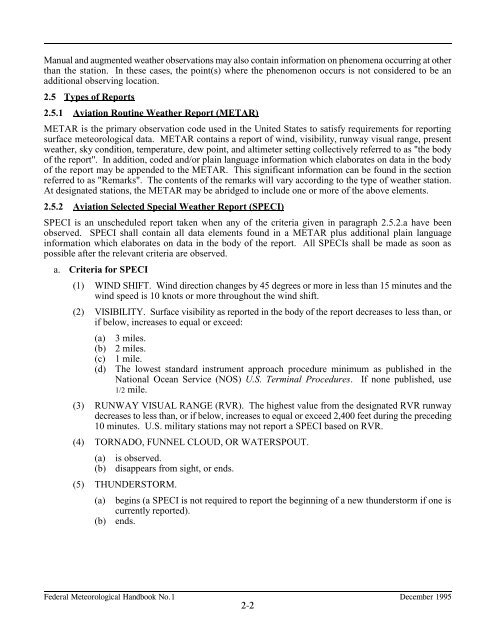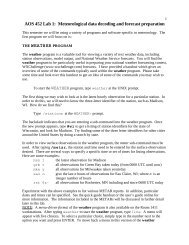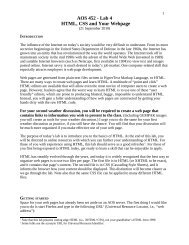Federal Meteorological Handbook No. 1 - Marrella
Federal Meteorological Handbook No. 1 - Marrella
Federal Meteorological Handbook No. 1 - Marrella
You also want an ePaper? Increase the reach of your titles
YUMPU automatically turns print PDFs into web optimized ePapers that Google loves.
Manual and augmented weather observations may also contain information on phenomena occurring at other<br />
than the station. In these cases, the point(s) where the phenomenon occurs is not considered to be an<br />
additional observing location.<br />
2.5 Types of Reports<br />
2.5.1 Aviation Routine Weather Report (METAR)<br />
METAR is the primary observation code used in the United States to satisfy requirements for reporting<br />
surface meteorological data. METAR contains a report of wind, visibility, runway visual range, present<br />
weather, sky condition, temperature, dew point, and altimeter setting collectively referred to as "the body<br />
of the report". In addition, coded and/or plain language information which elaborates on data in the body<br />
of the report may be appended to the METAR. This significant information can be found in the section<br />
referred to as "Remarks". The contents of the remarks will vary according to the type of weather station.<br />
At designated stations, the METAR may be abridged to include one or more of the above elements.<br />
2.5.2 Aviation Selected Special Weather Report (SPECI)<br />
SPECI is an unscheduled report taken when any of the criteria given in paragraph 2.5.2.a have been<br />
observed. SPECI shall contain all data elements found in a METAR plus additional plain language<br />
information which elaborates on data in the body of the report. All SPECIs shall be made as soon as<br />
possible after the relevant criteria are observed.<br />
a. Criteria for SPECI<br />
(1) WIND SHIFT. Wind direction changes by 45 degrees or more in less than 15 minutes and the<br />
wind speed is 10 knots or more throughout the wind shift.<br />
(2) VISIBILITY. Surface visibility as reported in the body of the report decreases to less than, or<br />
if below, increases to equal or exceed:<br />
(a) 3 miles.<br />
(b) 2 miles.<br />
(c) 1 mile.<br />
(d) The lowest standard instrument approach procedure minimum as published in the<br />
National Ocean Service (NOS) U.S. Terminal Procedures. If none published, use<br />
1/2 mile.<br />
(3) RUNWAY VISUAL RANGE (RVR). The highest value from the designated RVR runway<br />
decreases to less than, or if below, increases to equal or exceed 2,400 feet during the preceding<br />
10 minutes. U.S. military stations may not report a SPECI based on RVR.<br />
(4) TORNADO, FUNNEL CLOUD, OR WATERSPOUT.<br />
(a) is observed.<br />
(b) disappears from sight, or ends.<br />
(5) THUNDERSTORM.<br />
(a) begins (a SPECI is not required to report the beginning of a new thunderstorm if one is<br />
currently reported).<br />
(b) ends.<br />
������������������������������������ �������������<br />
���





